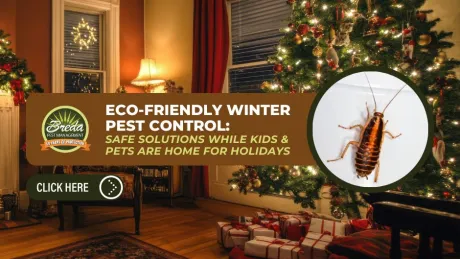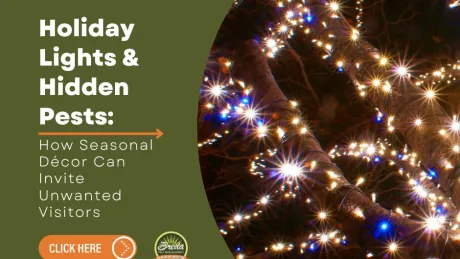Pests cause millions of dollars worth of damage each year in terms of ruined crops and disrupted commercial services. Many of them also carry different types of diseases that can harm or even kill humans and their pets. As a seasoned and reliable Atlanta pest control company, we are well aware of the dangers that pests pose to businesses, property values, and human lives. This is why we are committed to helping our customers rid their properties of all types of pests so they can enjoy a healthy, pest-free environment.
It is sometimes easy to overlook the damage that pests cause the plants that are part of your outdoor or indoor living spaces, but when left unchecked, any kind of pest presence can affect the quality of your yard's plant life.
Aphids
Aphids are also known as plant lice. These insects feast on the fluid and sap of plant tissues, reducing a plant's ability to utilize food and disrupting its growth. They secrete a honey-like substance that attracts ants. Most aphids native to Georgia are green or black, but depending on the species, aphids can be white, black, brown, gray, yellow, light green, or pink. Some can have a waxy, or furry appearance. Aphids feed on a variety of plants, but some species are more attracted to certain plants. There are bean aphids, cabbage aphids, potato aphids, green peach aphids, melon aphids, and woolly apple aphids.
Aphids usually stay in colonies that are visible on plant leaves and stems with close inspection. Below are some examples of aphids:
Aphids can make plant leaves misshapen, stunted, yellow, or curled. They usually feed on newer plant growth, and can usually be found on the undersides of leaves and on stems.
Here are a few ways to get rid of aphids:
- Spraying your plants with cold water, insecticidal soap, or horticultural oil dislodges, kills, and repels aphids
- Dusting your plants with flower can constipate aphids
- Wipe or spray leaves with a mixture of water and dishwashing detergent - mixing together 1 quart of water, 1 tsp of liquid dish soap, and a pinch of cayenne pepper has also shown positive results when sprayed on aphid infested plants.
- For best results, or for especially difficult cases, reapply spray every 2-3 days for 2 weeks.
- Purchase beneficial insects that prey on aphids like ladybugs, lacewings, and wasps.
- Plant companion plants like catnip, chives, and garlic that repell aphids
- Plant companion plants like mustard and nasturtium that can attract aphids off of your other plants
Caterpillars
Chewed leaves on your favorite perennials mean you have caterpillars. If you inspect the area immediately surrounding the affected leaves, you will likely find little black dots of caterpillar droppings. Earwigs are also voracious chewers and cause similar damage to plants.
Here are a few ways to get rid of caterpillars:
- Pick them off of your plants by hand
- Spraying your plants with Neem keeps harmful critters like caterpillars, whiteflies, leaf miners, and thrips away. It can also harm beneficial creatures like bees and earthworms.
- Dust plants with Bacillus thuringiensis (Bt) to get rid of caterpillars without harming other beneficial creatures.
- Put a bird feeder in your garden to attract caterpillar eating birds
- Buy a box of praying mantises to prey on your caterpillars
- Put porous polyester fabric around plants to allow light and moisture and block pests
- Plant lavender, mugwort, sage, and peppermint to repel caterpillars and other pests
(SFGATE)
Lilac Borers
When you notice small round holes in the bark of the shrubbery in your property, you may have lilac borers. They are also sometimes called Ash borers. These pests tunnel deep into the trunk of a shrub or tree to escape cold temperatures.
Here are a few ways to get rid of lilac borers:
- Identify infested branches and cut them off with gardening shears
- Put borer pheromone traps around your trees in April or May to cut down on new larvae
- Spray borer insecticide on the trunks of trees. Reapply insecticide 10 days after trapping borers in your pheromone traps
- Place mulch around your trees and keep it well watered
(SFGATE)
Grasshoppers
The damage that grasshoppers inflict on plants is quite distinct. As they only devour the flesh of the leaves between the veins and stems, all that's left is the skeleton of a leaf when they're done feasting on your plants. Grasshoppers can be a major problem because they have a ravenous appetite and can eat their weight in food in less than one day.
Here are a few ways to get rid of grasshoppers:
- Use grasshopper bait
- Use garlic spray
- Plant cilantroo in your garden to repel grasshoppers
- Dust your plants with flour
- Put spiders, praying mantises, beetles and other positive predators in your garden
- Let your grass grow tall in one back section of your yard. Grasshoppers are attracted to tall grass, and will prefer this section of your yard to your garden.
Webworms
Although these pests do not generally cause any long-term damage, they are extremely unsightly and can easily ruin a pretty garden. The moths typically show up in late summer and early fall and spin a web around the leaves they are eating, and a large population can easily cover a small tree in webbing. Webworms are usually an inch long and are yellow in color.
Here are a few ways to get rid of webworms:
- Use a rake or poll to break apart the webs
- Plant predator attracting plants around webworm infested trees
- Introducing wasps, spiders, or other predators
(HGTV)
As experienced Atlanta exterminators, we offer a variety of pest control services, including pest and termite inspection and effective pest control insulation. We are the Atlanta bug control specialists thousands of homeowners count on. Request a free consultation today and see why we have the trust of so many of your neighbors in the Peach State.



